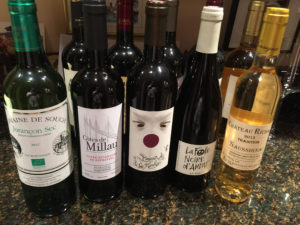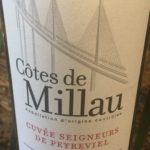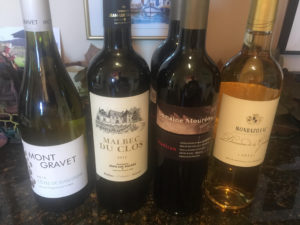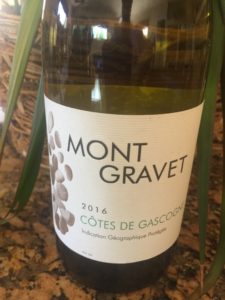Destination #2 Southwest France – the “Sud Ouest”
Can you name some grape varieties from the Southwest France wine region? I’ll bet that you already know some, but just aren’t aware that this is their original home. Read on if you find wine grapes intriguing and would like to hear more!
As mentioned in my previous “Destination #1: Southern Rhone Valley and Provence” article, I am always hoping to find quality new wines to try especially if they are produced from a grape I’ve never heard of! Looking for them in obscure countries or wine destinations is not currently an option for me, but my fingers can definitely travel around the internet researching those countries and grapes. I am always on the lookout for that next wine area to research and enjoy. When I read that the “Wine Enthusiast” Magazine selected Southwest France as its “2017 Wine Region of the Year”, I knew immediately that my new wine research project had just arrived!
Why did “Wine Enthusiast” Magazine make this selection? According to “Wine Enthusiast”, the nominee “had to prove it had more than wines of good quality; it had to demonstrate its vision, authenticity, and commitment to sustainable excellence.” Southwest France was in very good company with the other nominees being Galicia (Spain), Margaret River (Australia), Sonoma County (California) and Umbria (Italy). Southwest France had some stiff competition! Let’s explore why they were the winner, and I bet we will find some new grape varieties along the way.
Start off with a glass of Négrette?
As long as France has been a world leader in wine production and sales, how is it possible that Southwest France has not been on a wine lover’s radar? Well, 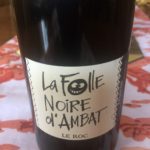 just think about when was the last time you drank a
just think about when was the last time you drank a 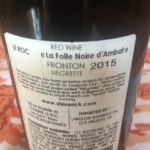 bottle of Négrette varietal wine from the Fronton AOP? Maybe a Jurançon Sec from the Jurançon AOP? Or an Irouléguy AOP wine from the Pyrénées? And of course, don’t forget a Monbazillac AOP wine with your dessert! What you may recall is enjoying a really great Malbec from Cahors, the birthplace of the Malbec grape. Cahors is the most famous of the Southwest France wine appellations.
bottle of Négrette varietal wine from the Fronton AOP? Maybe a Jurançon Sec from the Jurançon AOP? Or an Irouléguy AOP wine from the Pyrénées? And of course, don’t forget a Monbazillac AOP wine with your dessert! What you may recall is enjoying a really great Malbec from Cahors, the birthplace of the Malbec grape. Cahors is the most famous of the Southwest France wine appellations.
Southwest France is home to 43 geographical designations, covers 13 departments, and over 300 grape varieties referenced with 130 of them native to the region. The region ranks fourth in France for vineyard production volume, has 47,000 acres of vineyards and offers high-quality palate-friendly wines. Their wines are a good value for the money and pair easily with all kinds of foods. With the cost of wines continuing to rise in Bordeaux, Burgundy and Napa Valley, savvy sommeliers started touting Southwest France wines for their excellent value and finesse, and US consumers have started to catch on. We wine lovers of Southwest Florida don’t want to be left behind, so here is some information you may want to know.
Off to the “Sud Ouest”
The “Sud Ouest” (French for south west) is bordered by the Atlantic Ocean on the west and the Pyrénées Mountains on the south. It covers the upstream areas around the Dordogne and Garonne Rivers and their tributaries as well as the wine-producing areas of Gascony and the Northern Basque Country. With only 10 residents per square mile, it’s the least populated part of France. You may be familiar with Armagnac, a brandy-producing region which is also located within Gascony and Southwest France. Armagnac was one of the first areas in France to distill spirits. It is made from the same grapes that we will be learning about in the Southwest wine region.
The variation in soils is so wide throughout the region that it seems each grape has its own specific terroir. The soil in Fronton is perfect for the Négrette grape. At Gaillac one bank of the river is gravel – the other part clay and chalk. The terraces of the Lot at Cahors are perfect for Malbec. However sometimes Mother Nature doesn’t cooperate and hail from a summer storm can be a menace. A five minute burst may be enough to ruin the whole year’s crop. The weather plays a big role in wine production.
The 300 grape varieties of the Southwest can make wildly diverse high quality wines ranging from sparkling, to big reds, to crisp whites and some really unique styles. And even better — they come at affordable prices! The areas closest to Bordeaux make wine similar to Bordeaux-made wines, but there are several other very important grapes in the Southwest that you should know about – Tannat and Malbec.
Southwest France was first cultivated by the Romans and had a flourishing wine trade before the vineyards of Bordeaux were even planted, but has been in the shadows of Bordeaux, its very exclusive neighbor for many years. This part of France was known as the “High Country” and winemakers had to face many obstacles put in place to ensure that Bordeaux came out on top financially. Many wine merchants of Bordeaux felt threatened by the wines of their “High Country” neighbor. This led to the police des vins, a set of codes that were made official in the 13th and 14th century, which actually stated that no wine could be traded out of Bordeaux until the Bordelais wine had been sold. Wines from the “High Country” were left stranded at Bordeaux for weeks or months before they could be sold and when they were finally sold, they were assured to be at much lower prices than their neighbors in Bordeaux were paid! High Country families struggled to keep their vineyards afloat.
The new generation of Southwest winemakers are using trailblazing techniques that allow them to respect the environment and practice sustainability. They are also making more wines meant to be drunk young. They are attempting to create disease- resistant grapes, following organic practices and prefer to have minimal intervention in the vineyard and the cellar. They are wines that tell the story of the place they come from while paying respect to Mother Nature and the winemaker who got them into the bottle. It may still be a struggle but winemakers are finally receiving recognition for their work.
The Sud Ouest has a very rich cuisine – both in tradition and the actual food. Duck farms, strawberry fields and plum orchards are abundant in the countryside. Visions of duck confit, magrets, cassoulet, aligote, foie gras and truffles come immediately to mind, and they all pair perfectly with the wines of the region. The limestone plateaux above the Lot River are the center of truffle production. There is such a variety of grape varietals and wine styles that you can easily plan a multi-course food and wine pairing dinner based on wines of Southwest France. We foodie wine lovers have already learned that what grows together goes together!!! These are wines that not only pair well with food in France, but pair well with food here in the United States. In fact Jacqueline Malenda, a beverage director and sommelier, even named her New York wine bar “Madiran” after the appellation of Madiran that you will read about later. As Malenda puts it “ the wines are so expressive, unique and terroir-specific”. It appears that many of us wine lovers are not afraid to be adventurous and try new wines.
Regions of Southwest France, their appellations, grapes and wines
The four sub-regions
There are four sub-regions in the Southwest Wine Region made up of 29 Protected Designations of Origin or AOPs and 14 Protected Geographical Indication or IGPs. The PDO quality mark protects the name of a product in all member countries of the European Union. The AOPs or AOCs (which was a French specificity) are required to follow all of the regulations regarding growing the grapes and producing the wine. The IGPs are less strict with their vineyard and winemaking regulations; however 100% of the grapes have to originate in the IGP.
While there is a lot of information ahead, it really helped to clear up the French mystery of appellations, grapes and wines for me. Even though I have heard all about them a number of times in wine classes and reading wine books, it is difficult for me to remember. After all, I am a non-professional wine lover who happens to really enjoy the details about where my wine came from, how it grew, and who made it. Now that I am retired, this has become my full-time hobby. Every bottle of wine has some kind of story behind it, if you care to take the time to learn about it. So here is the list of four sub-regions and some information about each of them followed by the AOPs within each region.
1. Bergerac and Dordogne Sub-region
The Bergerac region is just south of Bordeaux with over 90 communes located along the Dordogne River with the city of Bergerac lying on the Dordogne River banks. There is a large English influence here. In fact some villages even have British residents outnumbering French. Wine has been made in Bergerac for thousands of years; land planted in vineyards grew significantly during the Middle Ages thanks to the monasteries who planted them on the banks of the Dordogne. The climate here is “maritime” – winters are colder and summers hotter than Bordeaux. Soils vary from limestone composed of ancient marine deposits, to gravelly clay known as boulbenes. Bergerac wines are certainly not as well known as their very exclusive and expensive neighbor Bordeaux. A good percentage of grapes here are grown for cooperatives which doesn’t always ensure high quality, but you can find good wine here. It is known for producing Cabernet Sauvignon, Merlot and Bordeaux blends at lower prices than Bordeaux, which is right along the same river. They also make white wines – Sauvignon Blanc, Ugni Blanc, Sémillon, Chenin Blanc. Some regional AOP names to know are: Bergerac, Montravel for dry white blends, Pecharmant famous for big reds and Saussignac, Rosette and Monbazillac all known for their sweet wines. There are good producers of white, rosé and red. Here are a few: Julie de Savignac, Châteaux Jaubertie, Belingard, L’Ancienne Cure, Vari, Tiregand, Chateau K. You will find excellent quality everyday wines of all colors in Bergerac. The difference in price from a Bordeaux will definitely make them worth a try!
Red grapes: Cabernet Sauvignon, Cabernet Franc, Merlot, Malbec (Cot), Fer and Merille
White grapes: Sauvignon Blanc, Ugni Blanc, Sémillon, Chenin Blanc, Muscadelle and Ondenc
Appellations of Bergerac and Dordogne:
Bergerac AOP, Bergerac Sec AOP and Bergerac Rosé AOP (1936) make wines of all colors with whites ranging from bone dry to sweet. Reds are Cabernet Sauvignon and Franc, Merlot, Malbec, and Fer Servadou. About 55% of wine produced here is red. Whites are Sémillon for dry and sweet, Sauvignon for dry and Muscadelle for sweet wines. These are wines to enjoy young. The Bergerac area has 13 appellations covering some 90 communes that center on the town of Bergerac, just 50 miles from the city of Bordeaux. All of the numerous Bergerac AOPs don’t help with the confusion and marketing of Bergerac wines. This large appellation-controlled growing region of 12,000 hectares produces over 6.6 million bottles of wine a year. A hectare is equal to 2.47 acres, so Bergerac has almost 30,000 acres under vine.
Côtes de Bergerac AOP and Côtes de Bergerac Blanc AOP (1936) are in the same area as Bergerac but generally produce mellow soft red wines considered to be a step up from Bergerac. They are often matured partially in the barrel with several years of storage in the wine cellar.
Monbazillac AOP (1936) has about 2000 hectares of vineyards located across the Dordogne River from the town of Bergerac. Monbazillac produces sweet white dessert wines made from the botrytized grapes of Semillon, together with Muscadelle and sometimes Sauvignon Blanc. Some people refer to it as “Sauternes’ country cousin”. 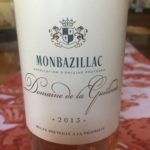 There are two types: Classique with about 70g/l of residual sugar per liter and the Selection de Grains Nobles with more than 85 g/l of residual sugar from shriveled grapes. The Grand Cuvees are only made in specific years with residual sugar levels over 150 g/l. These wines can be stored for a long time.
There are two types: Classique with about 70g/l of residual sugar per liter and the Selection de Grains Nobles with more than 85 g/l of residual sugar from shriveled grapes. The Grand Cuvees are only made in specific years with residual sugar levels over 150 g/l. These wines can be stored for a long time.
Montravel AOP (1937) consists of 1700+ hectares of vineyards in western Bergerac that produce mainly red wines and dry whites with a special minerality due to their height above the river. It has long been known for its production of fine dry whites from a blend of Sauvignon Blanc, Sémillon and Muscadelle. Merlot is required to make up at least 50% of the red blends. There is a separate appellation for Côtes de Montravel AOP (1937) which produces medium sweet wines and Haut-Montravel AOP (1937) that makes very sweet wines. The Sauvignon grapes are replaced with Sémillon and Muscadelle.
Pecharmant AOP (1946) is a red wine appellation of 400 hectares. Iron and manganese in the soil give the wines a robustness and ageing capacity above the regional average. Pecharmant takes its name from pech (hill) and charmant (charming) hence the “charming hill”. Four grapes grow here: Merlot, Cabernet Sauvignon, Cabernet Franc and Malbec. The maximum for any one variety is 65% and at least three varieties must be used. Pecharmant has long been considered the most noble red wine in the region and has been compared to Pomerol. The wines are almost always a good bet for classical wine lovers on a budget.
Rosette AOP (1946) makes semi-sweet white wines ideal to accompany foie gras or as an aperitif. Grapes are mostly Sémillon with a little Muscadelle. With 125 hectares, this is the smallest region in the Bergerac wine-growing area. Wines of Rosette are probably the most obscure in the Southwest France region.
Saussignac AOP (1982) has 900 hectares in vine and is even less known than Monbazillac. It produces white dessert wines similar to Monbazillac but with much more minerality. Permitted grapes are Sémillon, Muscadelle and Sauvignon Blanc all of which must be hand-harvested. They must have a residual sugar content of at least 68 g/l; however, they usually contain upwards of 130. Saussignac sweet wines are always liquoreux (very concentrated sweet wines) while Monbazillac ranges from semi-sweet (moelleux) to liquoreux. These wines are the most noble liquoreux of the region, are rich and thick, and can age for 10-20 years.
2.Garonne and Tarn Sub-region
Located further east near Toulouse, France’s fourth largest city, the Garonne and Tarn region has the same grape varietals as Bergerac and Dordogne, plus a few others. Fer Servadou, Gamay, Tannat, and Jurancon Noir are just a few. Here you will find very special AOPs like Fronton which has been famous since the Middle Ages as home to Négrette, a red grape that you most likely will not find anywhere else. Négrette makes wines with violet aromas and distinctive animal character. The oldest vineyards in the Southwest are right here in the Gaillac AOP, which is also the largest AOP.
Red grapes: Fer Servadou (native to Basque region of Spain), Duras, Gamay, Négrette, Syrah, Tannat, Abouriou, Prunelard, Cinsault, Jurançon Noir, Mouyssagues (almost extinct), Pinot Noir
White grapes: Len de L’el, Mauzac Blanc, Mauzac Rose, Saint Come (Rousselou)
Appellations of Garonne and Tarn:
Brulhois AOP (2011) is located between Toulouse and Bordeaux, mainly on the left bank of the Garonne River. It is known for deep-colored, robust powerful reds which tend to age well.
Brulhois reds are known as the “black wines” of the Southwest and exhibit black fruit aromas, along with licorice, prune, violet and spice. There is some rosé production (40%) making wines that are fresh, round and fruity on the nose with rich well-rounded fresh finish. Production in this 280 hectares of AOP is also dominated by the cooperative. Very few Brulhois wines are exported; most are sold at the cooperative or in local supermarkets.
Buzet AOP (1973) originally named Côtes du Buzet, changed to Buzet in 1986. Red, white and rosé wines are made from the main Bordeaux grapes. Buzet’s vineyards run along the Baïse River which flows into the Garonne. Reds outnumber the whites, but the tiny production of whites are made primarily from Sauvignon Blanc, Sémillon and Muscadelle. Rosé is usually made from Cabernet Franc. 2000 hectares of vineyards are planted here on limestone, clay, gravel and sandy soil with small pieces of limestone called boulbenes which helps the Cabernet Franc express more floral notes. Boulbenes range in size from marbles to golf balls and originated in the Massif Central mountain range until they were carried to the region by the Tarn River millions of years ago. The AOP is dominated by the Vignerons de Buzet cooperative which is thought to be one of the best run in France with almost 200 members. They don’t use synthetic fertilizers and chemical weed killers but they do encourage biodiversity.
Fronton AOP (1975), 1600 hectares of vineyards near the Garonne River just north of Toulouse, is the home of Négrette, a red grape which is almost exclusive to Fronton. Négrette “the little black grape” is a descendant of the Mavro grape of Cyprus and was brought here by the Knights of Saint Jean of Jerusalem centuries ago. Expect the aromas of violets and an “animal” character when you drink Négrette wine. 70% of red wines made here are from Négrette with soft fruity rosés making up the other 30%. Fronton is considered a microclimate where continental, oceanic and Mediterranean conditions meet. They have wet springs, dry summers and strong local winds. The soil is gravelly and rich with iron and quartz and terraces located high on hills that are steeper in altitude than most of this part of France.
Gaillac AOP (1970) is the largest producing appellation of the Southwest and claims to have the oldest vineyards. It is located between the cities of Toulouse and Albi ( a UNESCO World Heritage Site) and covers about 10,000 acres on both sides of the Tarn River. It is known for its diverse soils, wine styles and fruity reds . Twenty million bottles of wine are produced here annually. It is also home to more obscure local grapes: white Loin de L’Oeil, Mauzac and Ondenc and red Duras, Prunelard and Fer Servadou. They make sweet and sparkling wines here and “Gaillac Primeur” is similar to Beaujolais Nouveau. Sparkling is usually made by the old-fashioned “méthode Gaillacoise” – the wine is fermented only once and there is no added sugar or yeast. Gaillac is the most wide-ranging appellation in the Southwest with over a dozen permitted varieties and many different types and colors of wine.
Gaillac Premieres Côtes AOP, established in 1970, produces whites only. There is an underground water system to nourish the vineyards planted in limestone and clay. Because they are at the crossroads of the Atlantic and Mediterranean, they are lucky enough to receive the moisture laden winds of d’Autun. Wines offer notes green apple, pear and citrus fruits with freshness and elegance.
Côtes de Duras AOP (1937) is a southern extension of Bergerac vineyards spread across 15 communes on the right bank of the Dropt River, a tributary to the Garonne. It has a little over 2000 hectares and produces wines in all three colors. Sauvignon Blanc dominates the dry whites with some Sémillon, Muscadelle, Mauzac, and Chenin Blanc. Reds are Cabernet Sauvignon, Cabernet Franc, Merlot and Cot. The town of Duras is home to the Chateau de Duras first constructed in 1100s and now a tourist attraction.
Côtes de Millau AOP (2011) has 55 hectares of vines planted on the slopes of the Causses (a group of limestone plateaus in the Massif Central), north of the Gorges du Tarn where they watch over the Tarn gorges. Crossing the river became easier here with the building of the Millau viaduct, touted as the world’s tallest bridge with a tower summit of 1,125 feet above its base. The wines are mainly red: Fer Servadou (Mansois), Duras, Cabernet Sauvignon, Cabernet Franc, Syrah and Gamay. Rosés exude aromas of small red fruits. Whites are Chenin Blanc and Mauzac and are floral with a touch of dried fruits.
Côtes du Marmandais AOP (1990) is an appellation for fruity reds and rosés made predominantly from Cabernet Sauvignon, Cabernet Franc and Merlot with the possible addition of Malbec, Fer Servadou, Syrah, Abouriou and Gamay. The Abouriou grape (native to Lot and Garonne) almost disappeared between 1970 and 1980 but a conservatory was established in the region in 2004 to protect it. Abouriou gives high yields and is resistant to many maladies. Most of the AOP producers here belong to a cooperative. The city of Marmande is located just above the north bank of the Garonne River about 20 km south of Duras. Pruneau d’Agen, a famous prune also controlled by an appellation, is grown here; the region is also famous for its tomatoes.
Saint-Sardos AOP (2011) has just under 100 acres located on rolling hillsides and hills overlooking the left bank of the Garonne and the first hillsides of Lomagne. The main red grapes are Syrah (40% minimum) and Tannat (20% minimum) with some Cabernet Franc and Merlot for blending. This is the only vineyard in the Southwest where Syrah is the main grape variety. Saint Sardinian red wine has a very deep purple color with red and black fruits, spicy notes, licorice and floral aromas. This wine can wait five years in the cellar. The Holy Sardos rosé wine is bright pink with red fruit and floral aromas.
3.Lot River Sub-region
If you like Malbec, Lot is the region for you! The Cahors AOC is Malbec’s original home. Malbec has a long history with the royals of England and Russia. Half the wine shipped out of Bordeaux in the 14th century actually came from Cahors and Quercy. These wines were the favorite of the Orthodox Church and later the Tsars. Sadly this all ended by the end of the 19th century. Phylloxera wiped out the vines in the late 1800s. The vines were replanted with low-quality varieties which flourished but made low-quality wine. Then along came devastating frost in 1956 which destroyed most vineyards once again. This may have been a blessing in disguise as vintners now began to replant with different and better clones. Today you can find high-quality red wines from the Lot Region! You can also find rosés, delicate whites and reds that are perfect to drink now or age for later.
Grapes: Malbec plus same as those grown in the Garonne and Tarn Region.
Appellations of the Lot River:
Cahors AOP (kah-OR) is due north of Toulouse and one of the main appellations. It was established in 1971 exclusively for full-bodied red wines mainly from Malbec grapes. Malbec (also known as Côt or Auxerrois) has grown here for hundreds of years. In fact its first recorded reference was in the 16th century when it was called Auxerrois, one of its many names. Supposedly it was planted in Bordeaux by a Monsieur Malbeck. Eventually Malbec became one of the permitted red grape varieties in Bordeaux where it flourished for a few centuries but eventually was of minimal use there. Malbec had to rely on the travels of a French immigrant to Argentina who planted it in Mendoza wine country where it became a popular grape and wine. It became so popular in Argentina that it accounts for more than a third of the all black grape vines planted there and nearly 70% of the world’s Malbec vineyards. Argentina has approximately 100,000 acres compared with 10,000 in Cahors. Terroir plays a significant difference between the Malbecs of these two countries. Argentinian Malbec is fruit forward and plummy with a velvety texture and shorter finish while French Malbec is dark and inky, plummy with dark berries, savory and tart with structured firm tannins and a longer finish. Not only does the wine vary from the New World to the Old World but also from Cahors traditional style to big New World style depending upon the winemaker. Cahors Malbec has always been considered an excellent choice for cellaring. Some wine producers to know: Château du Cèdre, Clos de Gamot, Château de Haute-Serre, Château de Mercuès, Clos La Coutale, Château La Caminade, Château de Lagrézette, Château Saint-Didier-Parnac, Château Haut-Monplaisir, Château Chambert and Clos Triguedina.
If you enjoy reading about winemakers and challenges that they face on a day to day basis in order to keep their vineyards alive and producing amid soil concerns, the weather – no rain, downpours, hail storms, frost; quality of the grapes; harvest; and government involvement, you may enjoy reading “Families of the Vine”. Author Michael Sanders spent two years in the vineyards of southwest France with three families whose destinies are determined every year by the soil, weather, and quality of the grape. The three families are: Yves and Martine Jouffreau of Clos de Gamot, Philippe Bernède of Clos la Coutale and Jean-Luc Baldès of Clos Triguedina. They and their families have all been growing and producing Malbec wines in Cahors for many years. Their wines and their marketing strategies differ, but they are all dedicated passionate wine families producing high quality wines that I am eager to taste side by side. 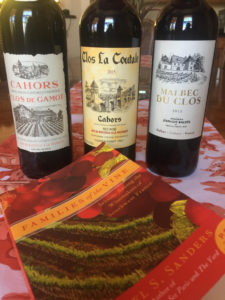
Coteaux du Quercy AOP got AOP status in 2011 and only makes big reds and rosés mainly from Cabernet Franc with Tannat, Gamay, Merlot and Malbec. Wine produced here must contain 40-60% Cabernet Franc and is generally rich and perfumed, fruity in youth and spicier as they age though not usually intended for long term aging. Wines from Quercy pair really well with famous local duck dishes like confit and magret. Quercy is located in the limestone hill country just south of Cahors.
Marcillac AOP (1990) is a small 420 acre appellation in the department of Aveyron and to the east of Cahors known for tannic reds and ripe rosés. They have a soft fruity character with a rustic edge, notes of spice, a pleasant tannic freshness and are made exclusively from the Mansois grape variety, the local name for Fer Servadou. Fer makes strongly concentrated intense red wines. You can drink these wines young or age them. As they mature, more complex aromas develop with hints of licorice and cocoa. Aveyron doesn’t get a lot of visitors but you foodies may also be interested in their famous Roquefort cheese and Laguiole knives and cutlery.
Entraygues et du Fel AOP was a small VDQS appellation given AOP status in 2011. It has steep terraced vineyards on rocky mountain slopes and gets the most sunshine in the region. The reds and rosés are mostly from Mansois, Cabernet Franc, Fer Servadou, and the whites from Chenin Blanc. It’s just 20 hectares!
Estaing AOP was also a small VDQS appellation until it became an AOP in 2011. With about 50 acres, located on the banks of the Lot River in Aveyron, it is one of the smallest in France. The Fer Servadou, Gamay, Cabernet Sauvignon and Cabernet Franc grape vines are planted on steep slopes and produce smooth reds perfect to enjoy young. Also 20 hectares!
4.Pyrénées Sub-region
A number of rare grape varieties can be found here near the mountain range that divides France from Spain. Some white wines are Gros and Petit Manseng, Lauzet (only 5 acres) Camaralet, Arrufiac and Raffiat but the really big wine of note is Tannat, the king of the Madiran AOP. Tannat is full of black fruit and spices with silky tannins and has been popular for centuries. Irouléguy is the only AOP in French Basque country and makes dry whites and earthy reds. Another AOP of note is Jurançon making white wines only. It is primarily known for sweeter wines but Jurançon Sec makes some very unique dry whites.
Red grapes: Manseng Noir, Tannat, Courbu Noir, Fer Servadou
White grapes: Camaralet (makes full bodied aromatic white wines), Gros Manseng (makes zesty white wines), Petit Manseng, Lauzet (only 5 acres in existence), Arrufiac, Raffiat, Courbu, Clairette Blanche, Baroque
Appellations of the Pyrénées:
Madiran AOP (1948) is the most famous AOP in the Pyrénées. It’s 1300 hectares surround the village of Madiran about 35 miles from the Pyrénées Mountains and 50 miles from the Atlantic Ocean. It is all about Tannat here – in fact there must be a minimum of 60% Tannat in any wines bottled here. Many of them are 100%. Madiran Tannat is often blended with Cabernet Sauvignon or Cabernet Franc because of its tight gripping tannins. Tannat is full of red to black fruit (black currant, blackberry, black plums), black licorice, vanilla, dark chocolate with possible notes of graphite, blood, iron, menthol, sandalwood, tobacco, cardamom, brown spices and smoke. It is not for those who prefer wine with finesse and elegance! Madiran Tannat pairs well with grilled meats with lots of fat around the edges and plenty of flavor, chocolate, and their local cuisine of lamb, goose, duck and sheep’s cheese. Madiran is in the department that is the largest producer of duck in France, and the number one producer of foie gras.
This wine has been popular for centuries but always took a backseat to Bordeaux. Thanks to progress in production techniques and a trend toward more full-bodied reds, Madiran is rapidly becoming a more important appellation.
Tannat has its roots in Madiran, but you may be drinking Tannat wines from Uruguay these days. It did take Uruguay to get a Tannat wine on the Wine Spectator Top 100 Wine List when a Tannat first appeared there in 2017. Bodega Garzon 2015 Reserve ranked #41, not bad! You can thank French immigrants for transporting Tannat to Uruguay in the late 1800s. French Tannat has more of the red fruit flavors and is a very powerful wine with elevated alcohol. Wines of Uruguay are usually softer with more pliable tannins and often blended with Pinot Noir, Merlot or Syrah to help bring those tannins down a notch or two.
Madiran is also famous for being a neighbor of Lourdes. It is about a 55 minute car ride to the city of Lourdes where you and six million other visitors every year can see the Sanctuary of Our Lady of Lourdes, a major place of Roman Catholic pilgrimage and miraculous healings. This constant stream of visitors has transformed the quiet city of Lourdes into the second most important center of tourism in France, second only to Paris.
Pacherenc du Vic-Bilh AOP (1948) covers the same geographical area as Madiran; however this AOC only allows dry white wines with tropical, honeyed, orchard fruit aromas and sweet whites reminiscent of fresh stone fruits and white flowers. Grapes planted are Arruflac, Gros Manseng, Petit Manseng and Petit Corbu, all whites. The Petite Manseng and Petite Corbu must make up at least 60% of the blend but no more than 80%.
Irouléguy AOP (1970) is the only AOP in the Basque area of France and is one of the smallest winegrowing regions in France. Only about 500 acres of vines are farmed here and just like numerous other locations, phylloxera destroyed the vines in the early 1900s. Vines are often planted on extremely steep mountain hillsides and produce expressive dry white and earthy delicate reds many that are indigenous to the area and quite rare. It has hot and dry autumns with southern winds. Basque winegrowers had to develop special growing and terracing techniques in order to utilize these slopes. The wines here are vastly different from any others produced in France. Irouléguy borders on Spain and the people who live here are more Spanish than French in customs and traditions. In fact the Basque Country has been seeking to officially become its own country! Most of these wines are robust Spanish-style reds. Reds (Cabernet Franc, Cabernet Sauvignon, Tannat) make up 70% of the production and are often dark and tannic with good potential for aging. You can expect aromas of candied fruit and spices. Winegrowers only produce 10% whites (Gros Manseng, Petit Manseng, and Petit Courbu) often with exotic fruits on the nose. Several notable producers are: Maison Arretxea, Domaine Brana and Herri Mina. Irouleguy is also notable for its sheep’s milk cheese, Bayonne ham and piment d’espelette, a spicy powder made from ground small red peppers.
Tursan AOP (2011) has 1,100 acres of vines producing whites, rosés and reds. The whites are dry and aromatic and made from the indigenous white grape Baroque. Reds are Cabernet Sauvignon, Cabernet Franc, Fer Servadou and Tannat.
Saint-Mont AOP (2011) lies in the Pyrénées foothills halfway between Toulouse and the Atlantic. Its hillsides are dotted with Romanesque churches, and vineyards existed here as early as the 11th century. The Benedictine monks planted the first vines in 1050, and their Saint Mont Monastery vineyards produce one of the AOPs great wines. Today’s vines average 30 to 50 years old with some ancient vines as old as 150 years. Winegrowers here are committed to native grape varieties, sustainable agriculture and the handing down of traditional practices. They make traditional style fruity reds with bold black fruit, fresh minerally whites and red berry rosés.
Jurançon AOP (1936) and Jurançon Sec AOP vineyards cover 932 hectares in the foothills of the Pyrénées in Basque country. Dry white wines are made in Jurançon Sec, but it is really known for its sweet wines that go by “Jurançon”. Jurançon is the king of the whites in the Pyrénées. These are also the most rare and unique grapes seldom seen elsewhere in the Pyrénées region. The wines are made from the same varietals; they are hand-harvested later in the season when sugar levels are really high. The vineyards are tucked away in sunny hillsides where the climate is a combination of oceanic, mountainous and southern influences. Many of the vines are trained to grow high to avoid damage from spring frosts. According to a story in French history, when the future King Henry IV was christened in 1553, his infant lips were touched with a drop of Jurançon wine, which was said to give him lifelong vigor. This practice is still repeated at many local christenings today. Classic Jurançon is a medium sweet wine balanced by fresh acidity and famous for its yellow color. It’s made from late-harvested Petit Manseng grapes left to raisin on the vine. 40% of production is Sec made from Gros Manseng blended with Petit Manseng and Corbu.
The story of Yvonne Hegoburu
Phylloxera hit the vineyards here like many others in the area, and unfortunately some winemakers re-planted with cheap French/American hybrids that made bad wine. Yvonne Hegoburu, a 90 year old woman, was featured in the movie “Mondovino” which looked into 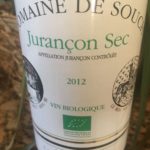 the wine trade in several countries and continents to examine how the production of wine has created aristocratic dynasties and class conflicts, and how small wineries fared. Small vineyards were visited along with large scale operations to determine if the wine business had become too commercial. Nearly 30 years ago she and her husband bought a run-down house in Jurançon AOP and then she planted vines to make a living after her husband passed away. She was experienced in the business management of wine, but didn’t know anything about viticulture! The first wine she produced was so good that it won an award in Paris in 1990. After 10 years of conventional farming, she joined a local Biodynamic growers group and converted her vineyards. By 1994, her work was complete and today her winery, Domaine de Souch, is one of the most revered Biodynamic producers in France. Her wines of Gros Manseng, Petit Manseng and Corbu are rare and memorable with dark gold color, complex aromas – musty, almost nutty, apple, honey and herbal taste like oregano, like crushed up rock and gasoline. This wine is not for everyone, but it is a memorable stand out!
the wine trade in several countries and continents to examine how the production of wine has created aristocratic dynasties and class conflicts, and how small wineries fared. Small vineyards were visited along with large scale operations to determine if the wine business had become too commercial. Nearly 30 years ago she and her husband bought a run-down house in Jurançon AOP and then she planted vines to make a living after her husband passed away. She was experienced in the business management of wine, but didn’t know anything about viticulture! The first wine she produced was so good that it won an award in Paris in 1990. After 10 years of conventional farming, she joined a local Biodynamic growers group and converted her vineyards. By 1994, her work was complete and today her winery, Domaine de Souch, is one of the most revered Biodynamic producers in France. Her wines of Gros Manseng, Petit Manseng and Corbu are rare and memorable with dark gold color, complex aromas – musty, almost nutty, apple, honey and herbal taste like oregano, like crushed up rock and gasoline. This wine is not for everyone, but it is a memorable stand out!
Petit Manseng has a balance of exotic sweetness and elevated acidity. Typical aromas include pineapple, papaya, mango and truffles. It can be picked early for dry wines or later for sweet wines reminding many tasters of demi-sec or sweet Chenin Blanc but with less minerality. Gros Manseng has a golden color with aromas of passionfruit and flowers with plenty of acidity. Courbu lowers alcohol and acidity found in the Mansengs. Lauzet has nearly disappeared. It works well in blends because of its rich alcohol and spice notes.
Béarn AOP (1975) is a very unique AOP that you may see listed as a separate wine region in some articles. It is located in the intersection of 3 French departments and 2 regions: Aquitaine and Midi-Pyrénées and includes the Béarn-Bellocq AOP created in 1991. Béarn wine can be made from 3 geographically different areas. First: Wine made in the Madiran AOP not fitting within those guidelines can be made for Béarn rosé wine. Second: The Jurançon AOP can make red and white Béarn. Third: This is a specific area especially for the Béarn AOP including the even more specific Béarn-Bellocq AOP (for wines made in the village of Bellocq). There are six reds: Cabernet Franc, Cabernet Sauvignon, Tannat, Fer, Manseng Noir and Courbu Noir. Raffiat de Moncade, Petit and Gros Manseng are a few of the whites.
Red Béarn wines have notes of dark berry fruits and should be drunk between two and five years after bottling. Béarn rosés have aromas of small red fruits and drink them young. These make up the majority of Béarn wines. A limited amount of white is produced and known as “Rousselet de Béarn”.
A little foodie tidbit
That very famous and oh so delicious Sauce Béarnaise was created by Chef Jules Colette at the Paris restaurant Le Pavillon Henri IV in the 19th century and named to honor the province of Béarn. King Henri IV was born in Béarn and was supposedly a “gourmet”. For any non-foodies, Béarnaise Sauce is a variation of Hollandaise, a French “mother sauce” and is made of emulsified egg yolks and butter, flavored with white wine vinegar, shallots and tarragon and is classically served on top of steak although it is quite delicious on seafood and vegetables. We foodies know that making Béarnaise can be quite challenging; in fact many classically trained chefs have their job applicants successfully demonstrate the preparation of “mother sauces” before hire! And if you don’t know what they are, don’t even show up for the interview! Here’s a bonus: the five French “Mother Sauces” are Bechamel, Hollandaise, Veloute, Espagnole, and Tomat.
The IGPs
Just to spice it up a little more, there are numerous IGPs and several like Côtes de Gascogne that are much larger in area with more relaxed rules and regulations but still make quality wines.
Côtes de Gascogne IGP, the top producing IGP, exports approximately 75% of its whites, red and rosés. It shares the same geography as Armagnac covering nearly 13,000 hectares. Known in English as Gascony, it has rich agriculture, rolling hills, medieval towns, sunny skies and is often called the “Tuscany of France”. They have been growing grape vines here for 2000 years. The ideal soils and knowledge of over 1200 local wine producers have made the wines of Côte de Gascogne a leader in Southwest France. 80% of these wines are made from local grapes such as Colombard, Gros Manseng, Sauvignon Blanc and Ugni Blanc which offer aromatic notes of citrus and exotic fruits. Côtes de Gascogne is now the largest white wine producing area in France and the largest wine-producing area in Southwest France. Red wines from Tannat, Merlot, Cabernet Sauvignon and Cabernet Franc make up 10% of the production with rosé taking up the remaining 10%.
Colombard is one of the world’s great blending grapes and is most famously used with Ugni Blanc and Folle Blanche to make Armagnac and Cognac. It is well suited for blending due to its neutrality but has also been a very popular single varietal white wine produced in Gascony for a number of years. French producers are now making some very nice Colombard wines. A good example is the 2016 Mont Gravet Côtes de Gascogne made from 100% Colombard with its fragrant aromas of fresh pears and peaches .
Colombard also traveled to North America where it was California’s premier white grape during the 1980s and was known there as “French Colombard”. Having lost most of that popularity in the US, now American Colombard is used in inexpensive white blends and jug wines.
Ever had a Floc de Gascogne? It’s a regional aperitif from the Côtes de Gascogne and Armagnac regions. It is a vin de liqueur fortified with Armagnac and has even had its own AOP status since 1990. The “recipe” calls for ⅓ Armagnac and ⅔ fresh grape juice both from the area and produced by same vineyard. Floc is produced in both white and rosé varieties, is between 16-18% alcohol and must be kept in the cellar of the producer for 10 months until approved by a committee of experts and sold under the Floc de Gascogne AOP. It is usually served as an aperitif but will surely make a great dessert drink with notes of almond, jasmine, roses, honey and black fruit.
Ariege IGP has an area of about 50 hectares from the southern edge of the plain to Toulouse at the foot of the Pyrénées. The terroir is made up of hillsides of hard rocks, eroded and sedimented in limestone. Red, rosé and white wines will remind you of earth and rocks with their mineral notes.
Aveyron IGP represents 20 hectares producing 80% red and 20% white and rosé wines on the beautiful landscapes of plateaus and hills on schists and granites alongside red sandstone in the highlands of Aveyron. Vines cling to hillside slopes and and dry stone walls. Red grapes Cabernet Sauvignon, Duras, Fer Servadou, Merlot and Syrah make original round and light red wines and delicious gourmet fresh rosés. White wines are fresh, light, round and fruity.
Comte Tolosan IGP is one of 5 regional IGPs in France. It covers 12 departments, a wide range of AOPs, and has a wide variety of terroirs and grape varieties. It exists to cover wines that are made outside of the regulations of these AOPs or with different grape varieties and winemaking styles. Wines are more white on the left bank of the Garonne and red and rosé on the right bank. There are 1300 hectares with the majority located on the Tertiary sedimentary lands of the Aquitaine Basin and on the ancient alluvial deposits of Quaternary terraces. Reds: Cabernet Franc, Cabernet Sauvignon, Côt, Duras, Gamay, Merlot, and Négrette which make light red wines with fruity notes and bright and lively rosés with spicy aromas. Whites: Chardonnay, Chenin, Colombard, Len de l’El, Gros and Petit Manseng, Mauzec and Muscadelle which make dry white wines with remarkable aromatic power and complexity and sparkling whites with an aromatic finesse and good acidity.
Côtes du Lot IGP covers about 500 hectares and makes lots of reds, but also amazing rosés and whites. It is located on the large limestone plateaus, the Causses du Quercy. Two large rivers cross the territory from east to west, the Dordogne and the Lot. Reds: Malbec, Gamay, Cabernet Franc, Cabernet Sauvignon and Merlot make aromatic wines with red fruit aromas ready to enjoy young. Rosés are becoming more plentiful and have fruity aromas and acid notes. Whites: Chardonnay, Chenin, Sauvignon, Semillon and Viognier make rich wines with an aromatic complexity and notes of pear, quince and white flowers.
Côtes du Tarn IGP is 2700 hectares in size and produces red wine from Gamay grapes, in fact 55% of the wine produced here. The IGP permits a large number of varieties both red and white many of which are no longer allowed in Gaillac. You can find it stretching northwest of the Tarn River including all of Gaillac and 41 other communes to the west, south and east.
Our journey is complete.
We just took a quick trip through the Sud Ouest or Southwest France wine region. It was quite different from the world famous French wine regions that we are so familiar with, as are the four sub-regions with their distinct differences. The wines of Bergerac and Dordogne are worth their value as an alternative to their higher price relatives in the Bordeaux region. The Garonne and Tarn wines are enjoyable for reds, whites and rosés, but be sure to try some of the indigenous grapes that you will probably never have anywhere else, such as Négrette wine of Fronton and maybe a Millau blend containing Fer Servadou or a Gaillac blend of Braucol, Alicante, Prunelard and Jurançon Noir! The Lot River sub-region will be quite memorable as our Malbec from Cahors has a special meaning to us now. Why not do a side-by-side comparison of a Cahors Malbec and a Mendoza Malbec to taste the differences for yourself? And then there is the Pyrénées sub-region where we learned that Madiran is the home to the Tannat grape. We will have to travel back to Basque country and enjoy another Irouléguy plus a Jurançon Sec from our friends at Domaine De Souche. Then after the dry wines, let’s have a little dessert and satisfy our sweet tooth with some excellent Southwest dessert wines from Monbazillac and Saussignac.
Wow! That was quite a trip and I certainly accomplished my objective of learning about new wines. I plan to taste wines from all of these regions quite soon at a “Wines and Cuisine of Southwest France” wine dinner. I’ll be sure to let you know about the fabulous pairings of Southwest France wines with foods such as Basque-style tapas, smoked duck breast, foie gras terrine, duck confit, white bean cassoulet, and Basque chicken. I can’t wait!
I agree with “Wine Enthusiast” Magazine on their selection. Wines of Southwest France proved to me that “it had more than wines of good quality; it had to demonstrate its vision, authenticity, and commitment to sustainable excellence.” Congratulations to the winemakers of Sud Ouest.
Note from the author:
Once again my major objective has been to introduce you to wines or wine regions that may be unfamiliar to you, or maybe you just have not visited wines from these regions lately. The article included some basic information about the regions, their grapes, their appellations and wines hopefully without too much “information overload”. All of this information is readily available on the internet along with some excellent books written by several reliable wine authors including Hugh Johnson & Jancis Robinson “The World Atlas of Wine”, Karen MacNeil’s “The Wine Bible” and Wine Folly “The Essential Guide to Wine”. I just did the research for you. Please accept my apologies if there is any incorrect data or information; I try my best to verify from several sources. I am an avid wine lover and foodie who also really enjoys researching and continuing to learn something new.
I hope my objective has been met and that you now are eager and excited to search out and taste wines from Southwest France. It is hard for me to write about wine without wishing that I had a glass of it in hand to taste! To remedy this situation, I’ll be tasting a number of them soon paired with food appropriate for each of the four sub-regions joined by some fellow adventurous wine lovers! Stay tuned for our menu, pictures of the food served and the wines we enjoyed! Bon appetit! À votre santé.
5.7.18

